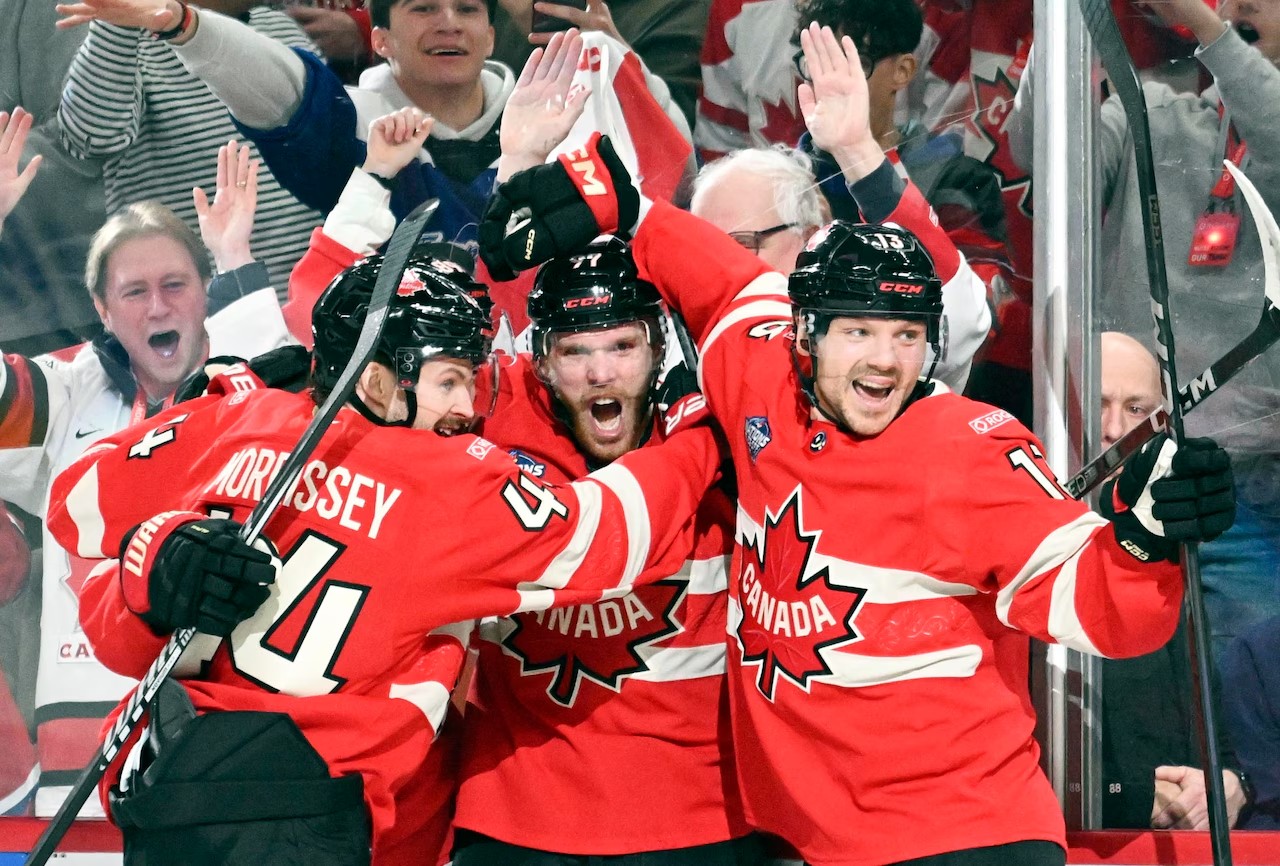Bring on the rematch.
In the meantime, your Game in 10:
1. Team Canada blew up their lines in this game and made some much-needed changes entering a do-or-die game. Both Mitch Marner and Sam Reinhart were taken off of Connor McDavid’s wings as neither really clicked with McDavid’s pace.
Instead, Brayden Point got the promotion, which makes sense because not only is the 46- and 51-goal scorer of the past two seasons talented enough to do it, but he has the speed to keep up with McDavid (as much as one can). Mark Stone was also bumped up, and while he definitely doesn’t have the speed, he provides them with a grinder to go to the net and forecheck (which is how they scored their first goal of the night).
Marner was shifted to a line with Hagel and Cirelli, entering more of a checking role rather than the high-end scoring role he started the tournament in. Marner has zero points at five-on-five so far, so you can’t really blame the coaching staff for this decision.
The one constant was MacKinnon and Crosby remaining paired up — and it was a good thing they did. They teamed up on multiple goals in this one. With Reinhart on their line, Sid seemed far more comfortable with the speed of play as both acted as diggers to facilitate MacKinnon, which worked well.
Seth Jarvis was scratched for Travis Konecny, which also made sense. Jarvis struggled and was out of his element in a physical battle against the States on Saturday. Konecny is theoretically a much better fit for that type of hockey, although he hasn’t distinguished himself in any meaningful way yet, either.
After Saturday, we said Jon Cooper and the staff would have to reflect on their choices, and they clearly did. They generally made good adjustments.
2. The game started off with the teams surprisingly trading some chances. That’s completely fine if you’re Canada, but not if you’re Finland.
The Finns did have a few good early chances, including a good shot by Mikael Granlund that Jordan Binnington just got a shoulder on, and an Esa Lundell point shot that got tipped, causing Binnington to search nervously behind him. Brayden Point had a good chance for Canada off the rush with his newly formed line, but it wasn’t until their next shift that McDavid broke the ice.
Stone’s effective forecheck led to a turnover right on McDavid’s tape at the top of the blue line in the offensive zone. He tried to attack but didn’t like the look, so he circled back, which created some space. Stone went to the net, and McDavid placed a great slow shot through the traffic, off the post, and in.
Canada has scored first in all three of their games so far, and McDavid has two of them.
3. Not even a minute later, Team Canada doubled their lead. The play resulted from an innocent battle at center ice, but Finland only had one player behind the puck. Brandon Hagel poked it up, and Canada immediately transitioned up the ice as Sam Reinhart took possession and Nathan MacKinnon burst right through the middle of the ice. Reinhart chipped it up to MacKinnon, who walked in all alone on a breakaway, curled, and snapped the puck, making no mistake with it.
4. Finland rightfully called a timeout after Canada made it 2-0 so early into the game, but it didn’t really matter. They generated some zone time and dulled the game down, but they struggled to get inside and create anything dangerous. This is a Finland team that thrives on tight checking, keeping games low-scoring, and getting better as the game goes along. But after racing to a 2-0 lead, Canada made it 3-0 to blow the game wide open.
The goal started on a Finland dump-in, where Cale Makar retrieved the puck and got it moving up ice quickly, leading to a transition chance off the rush. Canada obviously missed Makar big-time against the USA — he’s the best defenseman in the world — and even though he didn’t collect a point on this play, he started it.
McDavid took the puck from there and raced up the ice, and Travis Sanheim activated as a fourth forward on the far side, making a 3v3 rush a 4v3 odd-man rush. Sanheim is really adept at joining the rush and was effective at this vs. the US as well. McDavid found him with a backside pass, Sanheim took a good low shot, and Brayden Point quickly pulled the puck from his forehand to his backhand around Lankinen and into the empty net for his first goal of the tournament.
5. In a stat that demonstrates not only how dangerous Canada was in the first but how inadequate they were offensively prior to this game, they created six slot shots in the first against Finland compared to their eight total at five-on-five in the two games prior.
Five minutes into the second, MacKinnon scored his second of the game on yet another slot shot. After a Sidney Crosby forecheck caused a turnover, Sam Reinhart supported the puck and poked it back to Crosby, who bumped it to MacKinnon in the slot. Once again, it was a no-doubter from MacKinnon in that spot.
Finland pulled Lankinen for Saros after the 4-0 goal, which had just as much to do with Lankinen as it did with the team in front of him. Finland didn’t have much choice, but it didn’t exactly spark them, either.
6. Shot attempts were recorded as 18-18 in the middle frame, but Canada controlled most of the period, and Juuse Saros had some really good sequences, including stonewalling Makar a few times. Finland’s best looks came on a late power play at the end of the second, but the much-maligned Binnington stood tall on a few chances in tight. Finland never threatened to make this game, and the power play felt like their last real chance to get something and provide some hope in the third period.
Through two periods, it was also a good example of why we should not rely on the stats fully; Canada was credited with an expected goals of 1.5, but look at their goals: MacKinnon’s breakaway, McDavid walking in the slot with time and space, MacKinnon’s one-timer in the slot, and a 4v3 with a wide open look followed by a rebound. And those are just the chances they converted.
This is not to say expected goals are a worthless stat that should be completely disregarded, but some caution should be exercised when they are used in the context of a single game.
7. Finland made no real push to start the third period. In fact, Canada was just rolling their lines and largely controlling the play in Finland’s zone. Canada did a good job of managing the puck and the clock, and Finland mustered a total of four shots on net through 16 minutes of the period despite trailing 4-0. That pretty well sums it up.
However, one of those shots did turn into a goal as Brad Marchand got beat on the wall by Lundell and turned it over in the middle of the ice. The puck was poked right back to Lundell, who placed a good shot far side blocker, off the post, and in. It was, truthfully, a really good shot from that spot.
8. I thought it was noteworthy that Canada delayed using Marner to defend in the 6v5 situation as Finland pulled their goalie. Hagel and Cirelli were centered by McDavid for a defensive-zone faceoff as Marner was moved off that line for the situation, although Marner did join the next shift with Point and Stone.
It was not that the goal was specifically Marner’s fault, but Finland scored on the 6v5 as Patrik Laine unloaded multiple one-timers on his side, the second one being more of a slap pass that poked right back out to him. Laine made a good play to pass it to Granlund in the slot rather than force a shot through traffic. Granlund took the puck in the high slot against a sprawling Binnington and made no mistake, cutting Canada’s lead to 4-2.
Marner played just 12:46 for the night — only Konecny played less amongst Canada forwards. For context, Reinhart led the team with 16:37, so it’s not like they rode the top dogs to the ground, but it’s still discussion-worthy that Marner was 11th out of 12 among forwards in time on ice.
9. At 4-2, the game still felt very much over, but just 23 seconds after making it 4-2, Finland made it 4-3, and there was still over a minute left of game time to go.
Off a simple dump-in, Canada couldn’t recover the puck and get it out. First, it rimmed around, and McDavid was first on it and couldn’t control it. Then, Sanheim couldn’t before McDavid and Doughty started chasing the puck as Rantanen bumped it down low to Aho, who tapped it out to Barkov.
Barkov made a heads-up play to pass it to Granlund open in the slot instead of shooting himself, and Granlund had time and space to snipe one into the top corner. A bad breakdown by Canada made it very much game on.
10. I was surprised that Canada didn’t use a timeout at 4-3. Instead, they took the McDavid line off and the defense pairing of Sanheim-Doughty, turning to the MacKinnon line and the Toews-Makar pairing. From there, Crosby took over.
First, Crosby laid a big hit at center ice on Granlund to create a turnover and prevent Finland from even dumping the puck in. He then cradled the bouncing puck over center to avoid any sort of icing and batted at the puck, scoring the empty netter to ice it at 5-3.
Finland didn’t threaten to score again until about five seconds left in the game. For Sid, it’s another big-time Canada moment that caps a really good response game from him after he struggled against the US on Saturday. He ended the night with a goal and assist and has five points in the tournament — as the tournament’s oldest player. Absolute gamer.



































